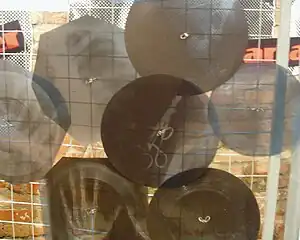
Ribs (рёбра, translit. ryobra), also known as music on ribs (Музыка на рёбрах), jazz on bones (Джаз на костях), bones or bone music (roentgenizdat), are improvised gramophone recordings made from X-ray films. Mostly made through the 1950s and 1960s,[1][2] ribs were a black market method of smuggling in and distributing music that was banned from broadcast in the Soviet Union. Banned artists included emigre musicians, such as Pyotr Leshchenko and Alexander Vertinsky, and Western artists, such as Elvis, the Beatles, the Rolling Stones, the Beach Boys, Ella Fitzgerald and Chubby Checker.[3][4]
Production
Medical X-rays, purchased or picked out of the trash from hospitals and clinics, were used to create the recordings. The X-rays were cut into 7-inch discs[5] and the center hole was burned into the disc with a cigarette.[6] According to Russian music critic and rock journalist Artemy Troitsky, "grooves were cut [at 78rpm][5] with the help of special machines (made, they say, from old phonographs by skilled conspiratorial hands)"; he added that the "quality was awful, but the price was low, a ruble or a ruble and a half."[7] The disks could be played five to ten times.[8]
Legality
The clandestine approach to circulating banned popular foreign music eventually led to a law being passed in 1958 that forbade the home-production of recordings of "a criminally hooligan trend".[5] The "hooligan trend" refers to the stilyagi (from the word stil meaning style in Russian), a Soviet youth subculture known for embracing Western styles of dress and dance.[9]
The X-Ray Audio Project
While on tour with The Real Tuesday Weld in Saint Petersburg, the English musician Stephen Coates came across an X-ray record at a market stall. Coates was inspired to launch The X-Ray Audio Project, an initiative to provide a resource of information about roentgenizdat recordings with visual images, audio recordings and interviews.[10] In November 2015, after several years of research and interviewing bone bootleggers, his book X-Ray Audio: The Strange Story of Soviet Music on the Bone was published by Strange Attractor.[11]
In June 2015, Coates gave a TED talk on the subject at TEDX Kraków.[12] He and sound artist and researcher Aleksander Kolkowski went on tour, telling the story of the Soviet X-ray bootleggers and cutting new X-ray records from live musical performances as a demonstration of the process. The touring exhibition Coates created with photographer Paul Heartfield was covered in The Guardian and on BBC Radio 4's Today programme.[10][13] In September 2016, the pair released the long-form documentary Roentgenizdat featuring interviews with original Soviet-era bootleggers and archive footage.
In 2019, Coates wrote and presented Bone Music, a documentary based around interviews carried out in Russia for an edition of BBC Radio 3's Between The Ears series. The programme told the story of underground culture of forbidden music in Cold War era Soviet Union and featured the Russian band Mumiy Troll recording a Vadim Kozin song cut straight to X-ray.[14]
See also
References
- ↑ Raleigh, Donald J. (2006). Russia's Sputnik Generation: Soviet Baby Boomers Talk about Their Lives. Indiana University Press. p. 69. ISBN 978-0-253-21842-1.
- ↑ Minor, William (1995). Unzipped Souls: A Jazz Journey Through the Soviet Union. Temple University Press. p. 2. ISBN 978-1-56639-324-9.
- ↑ Starr, S. Frederick (1983). "The Rock Inundation". The Wilson Quarterly. 7 (4): 58–67. JSTOR 40257510.
- ↑ West, Richard (25 June 1965). "REDS LIKE ROCK AND ROLL---BUT NEED INTERPRETATION". Los Angeles Times. p. 1 – via ProQuest.
- 1 2 3 Ganley, Gladys D. (1996). Unglued Empire: The Soviet Experience with Communications Technologies. Greenwood Publishing Group. pp. 4, 10. ISBN 978-1-56750-197-1.
- ↑ Wilson, Clare (9 December 2015). "Soviet-era bootleg music recorded on discarded X-ray plates". New Scientist. No. 3051. pp. 24–25. Retrieved 13 February 2016.
- ↑ Easton, Paul (1989). "The Rock Music Community". In Riordan, James (ed.). Soviet youth culture. Vol. 2. Basingstoke: Macmillan. p. 47. ISBN 0-333-46231-9. OCLC 246807650Available at University of Indiana
{{cite book}}: CS1 maint: postscript (link) - ↑ Logan, Wendell; Yrina, Satrina; Lebedev, Victor (1992). "The Development of Jazz in the Former Soviet Union: An Interview with Victor Lebedev". Black Music Research Journal. 12 (2): 227–232. doi:10.2307/779443. JSTOR 779443. Retrieved 17 August 2021.
- ↑ Edele, Mark (2002). "Strange Young Men in Stalin's Moscow: The Birth and Life of the Stiliagi, 1945–1953". Jahrbücher für Geschichte Osteuropas. 50 (1): 37–61. JSTOR 41050842.
- 1 2 Paphides, Peter (29 January 2015). "Bone music: the Soviet bootleg records pressed on x-rays". The Guardian. Retrieved 24 December 2015.
- ↑ Coates, Stephen (2015). X-Ray Audio: The Strange Story of Soviet Music on the Bone. Strange Attractor. ISBN 978-1-907222-38-2.
- ↑ Coates, Stephen (6 August 2015). The story of X-Ray Audio: What would you risk for the sake of music?. TEDxKraków. Retrieved 17 August 2021.
- ↑ Hear the banned Soviet music recorded onto X-Rays (Radio broadcast). Today. 27 January 2015. Retrieved 21 May 2021.
- ↑ "Bone Music". Between the Ears. BBC. 17 November 2019. Retrieved 17 August 2021.
Further reading
- Coates, Stephen (Ed.) (2015). The strange story of Soviet music on the bone. London: Strange Attractor Press, ISBN 978-1-907222-38-2
- Yurchak, Alexei (1999). "Gagarin and the Rave Kids". In Barker, Adele Marie (ed.). Consuming Russia: popular culture, sex, and society since Gorbachev. Durham, N. C.: Duke University Press. p. 82. ISBN 978-0-8223-2313-6. OCLC 185952345.
- Yurchak, Alexei (2006). "Chapter 6: Imaginary West". Everything Was Forever Until It Was No More: The Last Soviet Generation. Princeton University Press.
External links
- X-Ray Audio
- The Horse Hospital Archived 21 October 2014 at the Wayback Machine
- Roman Tschiedl: Bootlegs auf Röntgenfilm: Der illegale Sound des Kalten Krieges, Radio OE1, 2. April 2016 (German/English, Interviews with Stephen Coates, Aleksander Kolkowski and Masha Dabelka on Ribs recordings)